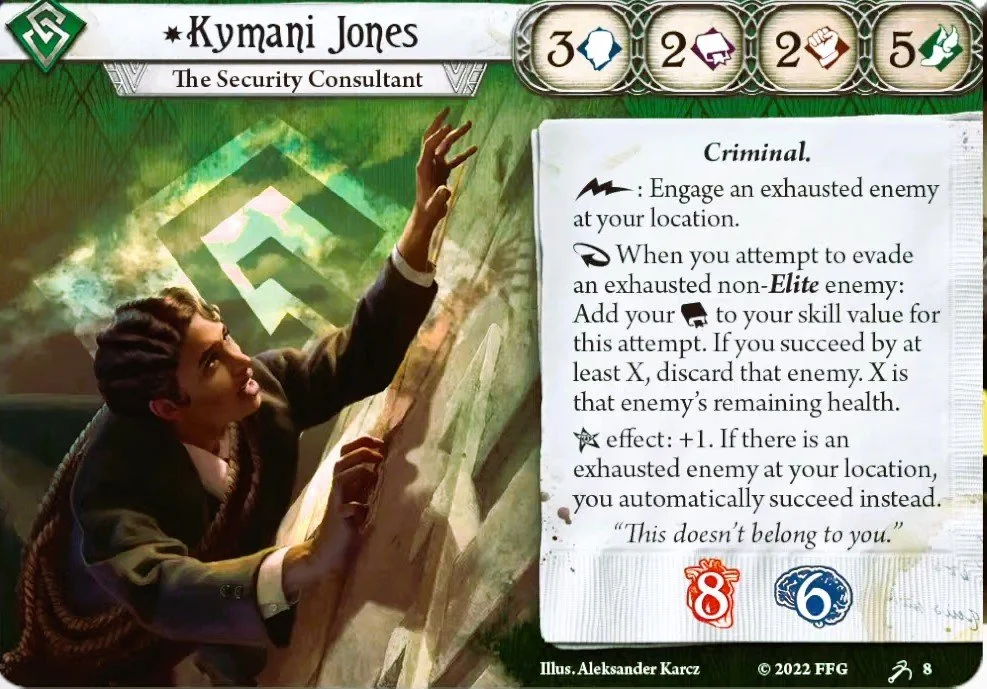Arkham Horror, Museums & Repatriation
Kymani’s character card in Arkham Horror: The Card Game. Credit: Fantasy Flight Games.
Continuing on the Lovecraftian theme, I wanted to go into a bit more detail about Kymani Jones, one of the newest investigators in the franchise and one who has a very interesting backstory where it concerns museums that have a lot of relevance for the state of museums & archaeology today.
Kymani Jones is labeled in game as “The Security Consultant” and the developers put them in the Rogue category, which is 1 of 5 character classes in the game that shape how a character navigates the game’s challenges. I talked more about the Arkham Horror franchise here, but this time I want to focus on museums specifically.
“That doesn’t belong to you.”
Kymani was a new addition to the game with The Scarlet Keys expansion, which might require another article later, and they were also the first character in the game to be added with they/them pronouns. The biggest bit of backstory for Kymani we have so far is the back of their character card, which reads as follows:
“When the Taino artifacts went missing from the Miskatonic Museum, Kymani was hired to assess the museum’s liability. Of course, Kymani already knew who the thief was - it has been their own heist, all along. But Kymani had no interest in selling the relics. As far as Kymani was concerned, they weren’t the ones who really stole them. No; Kymani had sent the historical artifacts back home, where they truly belonged. The museum and the insurance company see only a villain to catch, but Kymani is faster, smarter, and better.”
There’s a lot - and I mean a lot - to unpack there, and given that this is happening in the fictional world of the game in the early 1920s, it is surprisingly relevant to today. While museums heists are often the plot of popular movies, this is very much a real, and very complex, problem that continues today.
As I mentioned before, the past has currency that makes looting extremely valuable, and until recently it was common practice and considered normal to also loot the artifacts of conquered nations until more international laws about what could be taken by the victors was agreed upon. That means that things like the Benin Bronzes or Indigenous artifacts from the Americas ended up in enemy hands and now there are many, many more cries for museums to return these once-stolen goods.
Kymani represents someone who is the opposite of a looter in that they steal things from the museum and then return them to the place they were taken from. In 2018, this article was released that described art heists taking place across Europe from 2010 to the present with similar tactics and targets that all had to do with significance to Chinese history.
It is frustrating for groups that have been constantly asking for artifacts back with seemingly no response - or a very delayed one - and as Kymani believed, they might not see a problem with stealing back what was once stolen from them. For the longest part of history, the world operated on “Finders Keepers” but now that people want things back and are willing to steal to take them back, there is the question as to whether they have the right to do that.
“Desperate people return stolen propriety by committing a theft.”
Is it right? Can it be considered stealing if they are stealing something stolen from them? Is it not their ancestral heritage? It’s such a complicated problem and the backstory of Kymani sums all that up in just a paragraph of fictional text. They don’t see a problem with this and they never will. It’s likely a lot easier to do so in the 1920s, before mass security systems and alarms on every glass case, but it’s still happening.
The British Museum recently lost its director, Hartwig Fischer, along with nearly 2000 items from its collection that were missing, stolen, or damaged (See the article from The Guardian here). In addition, this called into question the idea that the British Museum considers itself the “imperialist” stance of being the one (and often only) caretaker of the world’s history, and with any luck this incident will force the museum’s policy to change (It likely won’t).
At any rate, it’s a question no one has a perfect answer to and may never get resolved. Often Western museums cite security issues and questions like, “What if they destroy or resell these artifacts if we give them back?” to avoid repatriation, but perhaps they have the right to do so if it always belonged to them. Kymani is an interesting example for this conversation, being basically a counter-agent to the Lovecraftian archaeologist who continually digs up and uncovers treasures they were not supposed to. It’s a good foil, and it brings up a lot of interesting questions for us today. All in a card game.
That’s all for today folks! I have a few different ideas for what I might do next. I had planned to move away from Lovecraft for a bit but he just keeps coming back (the true horror of being an archaeologist) so tune in next week to see what’s coming next. For now, what tabletop games do you enjoy playing?




